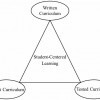Abstract
Deciding what students need to know through the development of declarative objectives, deciding what students need to able to do through the development of procedural objectives, considering how to evaluate student learning, and planning meaningful learning experiences will allow for effective instructional planning. Following these basic steps will allow educators to determine the specific goals of the lesson, the course, or the program in order to effectively prepare students. This 4-page fact sheet was written by Sarah E. Burleson and Andrew C. Thoron, and published by the UF Department of Agricultural Education and Communication, April 2014.
References
Bloom, B. S. (1956). Taxonomy of educational objectives, Handbook 1: The cognitive domain. New York: David McKay Company.
Schunk, D. H. (2012). Learning Theories: An educational perspective (6th ed.) Boston, MA: Pearson Education.
Stoughton, A. L., & Myers B. E. (2008). Creating and working with rubrics (EDIS Publication No. AEC 388). Retrieved from http://edis.ifas.ufl.edu/wc069 https://doi.org/10.32473/edis-wc069-2008
Tileston, D W. (2004). What every teacher should know about instructional planning. Thousand Oaks, CA: Corwin Press.

